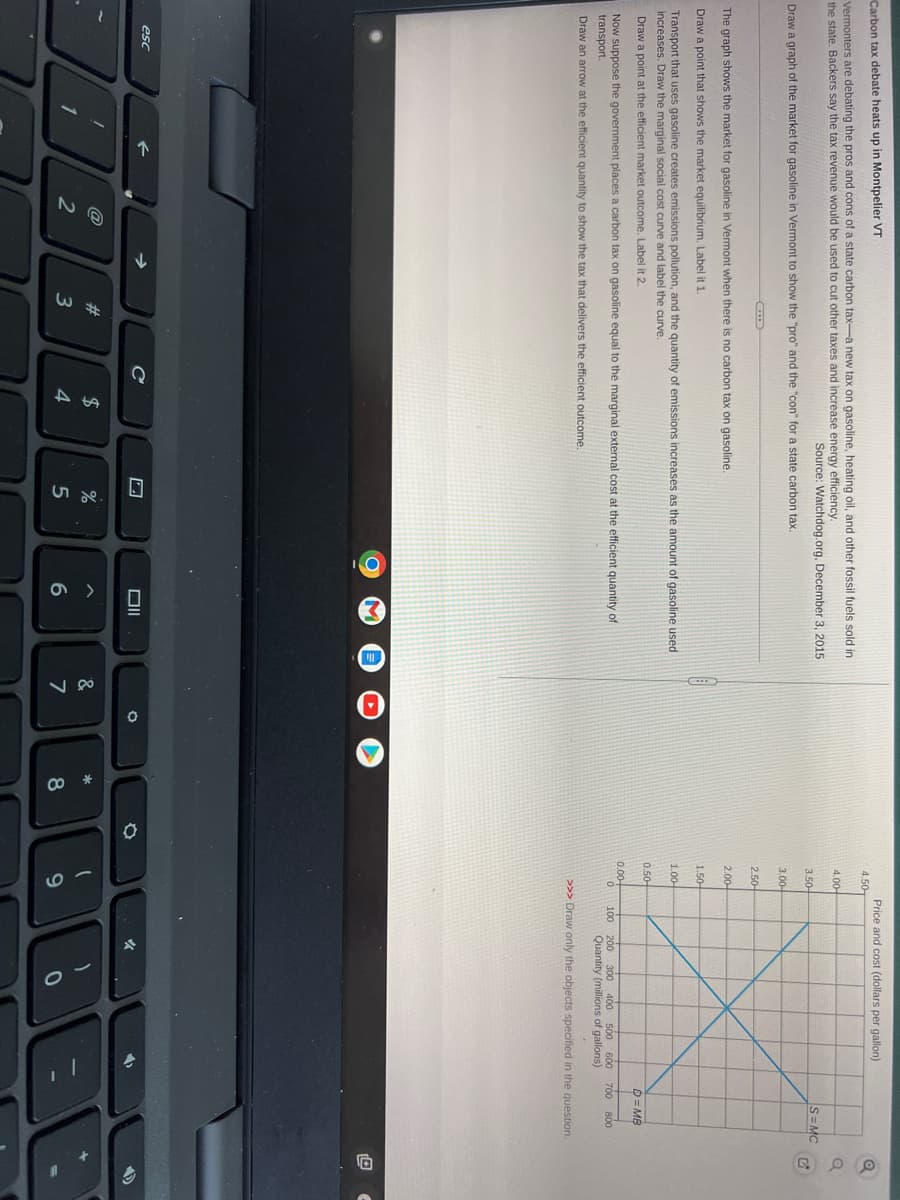on tax debate heats up in Montpelier VT monters are debating the pros and cons of a state carbon tax-a ne- tate. Backers say the tax revenue would be used to cut other taxes va graph of the market for gasoline in Vermont to show the "pro" an graph shows the market for gasoline in Vermont when there is no c w a point that shows the market equilibrium. Label it 1. nsport that uses gasoline creates emissions pollution, and the quant reases. Draw the marginal social cost curve and label the curve. raw a point at the efficient market outcome. Label it 2. ow suppose the government places a carbon tax on gasoline equal to ansport. raw an arrow at the efficient quantity to show the tax that delivers the
on tax debate heats up in Montpelier VT monters are debating the pros and cons of a state carbon tax-a ne- tate. Backers say the tax revenue would be used to cut other taxes va graph of the market for gasoline in Vermont to show the "pro" an graph shows the market for gasoline in Vermont when there is no c w a point that shows the market equilibrium. Label it 1. nsport that uses gasoline creates emissions pollution, and the quant reases. Draw the marginal social cost curve and label the curve. raw a point at the efficient market outcome. Label it 2. ow suppose the government places a carbon tax on gasoline equal to ansport. raw an arrow at the efficient quantity to show the tax that delivers the
Microeconomics: Principles & Policy
14th Edition
ISBN:9781337794992
Author:William J. Baumol, Alan S. Blinder, John L. Solow
Publisher:William J. Baumol, Alan S. Blinder, John L. Solow
Chapter4: Supply And Demand: An Initial Look
Section: Chapter Questions
Problem 4DQ
Related questions
Question

Transcribed Image Text:Carbon tax debate heats up in Montpelier VT
Vermonters are debating the pros and cons of a state carbon tax-a new tax on gasoline, heating oil, and other fossil fuels sold in
the state. Backers say the tax revenue would be used to cut other taxes and increase energy efficiency.
Source: Watchdog.org, December 3, 2015
Draw a graph of the market for gasoline in Vermont to show the "pro" and the "con" for a state carbon tax.
The graph shows the market for gasoline in Vermont when there is no carbon tax on gasoline.
Draw a point that shows the market equilibrium. Label it 1
Transport that uses gasoline creates emissions pollution, and the quantity of emissions increases as the amount of gasoline used
increases. Draw the marginal social cost curve and label the curve.
Draw a point at the efficient market outcome. Label it 2.
Now suppose the government places a carbon tax on gasoline equal to the marginal external cost at the efficient quantity of
transport.
Draw an arrow at the efficient quantity to show the tax that delivers the efficient outcome.
esc
106
2
*3
$
4
A
25
%
Oll
6
&
7
O
*
8
O
4.50
4,00
3.50-
3.00-
2.50
2.00
1.50-
0.50
0.00€
(
Price and cost (dollars per gallon)
9
100 200 300 400 500 600
Quantity (millions of gallons)
>>> Draw only the objects specified in the question.
1
O
S=MC
1'
D=MB
700 800
Q
G
Expert Solution
This question has been solved!
Explore an expertly crafted, step-by-step solution for a thorough understanding of key concepts.
Step by step
Solved in 2 steps with 1 images

Knowledge Booster
Learn more about
Need a deep-dive on the concept behind this application? Look no further. Learn more about this topic, economics and related others by exploring similar questions and additional content below.Recommended textbooks for you

Microeconomics: Principles & Policy
Economics
ISBN:
9781337794992
Author:
William J. Baumol, Alan S. Blinder, John L. Solow
Publisher:
Cengage Learning

Microeconomics: Principles & Policy
Economics
ISBN:
9781337794992
Author:
William J. Baumol, Alan S. Blinder, John L. Solow
Publisher:
Cengage Learning